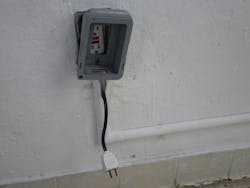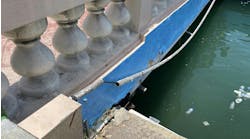Hint: Slip sliding away
The cover for this outside receptacle outlet is broken and has slipped off one of its mounting screws leaving the receptacle unprotected from rain, snow, sleet, and any other elements Mother Nature can throw at it. Section 110.12(B) prohibits damaged parts that may adversely affect the safe operation of the equipment including parts that are broken, bent, cut, or deteriorated. This cover, and probably the GFCI receptacle too, should be replaced to bring this installation back to a Code-compliant and safe installation. Section 406.9(B)(1) requires the enclosure for this GFCI receptacle to be weatherproof with or without an attachment plug inserted. This may have complied with that requirement when it was originally installed, but this cover certainly does not provide a weatherproof enclosure now. This 15A, 125V GFCI-type duplex receptacle must be listed and identified as a weather-resistant (WR) type. As for the cord, I’m not sure it is suitable for use in the outdoor wet location. Using cord sets, flexible cords, flexible cables, or power supply cords as a substitute for fixed wiring of a structure is a violation of Sec. 400.12(1).





